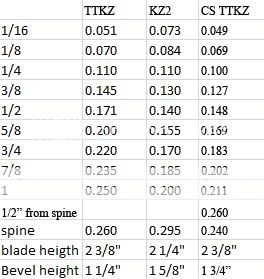Last Visible Canary
actively parsing hurf durf
- Joined
- Nov 28, 2006
- Messages
- 4,577



*bling*


In response to adrock1978's thread about handles turning in your hand while chopping, this is why I consider this a good handle for avoiding torqueing in the hand. The center swell is fairly thick, but throughout it maintains a profile that is more flat then round, especially at the index and pinky positions:
index - 1 3/16" tall, 10/16" thick
middle - 1 7/16" tall, 15/16" thick
pinky - 1 4/16" tall, 11/16" thick


This is a chart of the difference in this custom shopped TTKZ's grind vs. the stock TTKZ and KZ2. It's edge is thinner then the KZ2 up to the the 3/8" mark at which point the CS TTKZ gets a little thicker. The KZ2 has a flat (or nearly flat) grind that starts out thicker, and ends thicker then the TTKZ but is thinner in the middle. If I had continued these measurements you'd see that at the 1 3/4" mark the TTKZ would be thinner then the KZ2 since it's stock thickness is 0.260" vs. 0.295". I realized when measureing this that the CS TTKZ thins out from about 1/2" down from the spine to the spine, going from .260 to .240.
Even though this flattening/thinning didn't quite get it as thin or flat as the KZ2 at the center of the blade, it's a definite improvement over it's original geometry. I would take this over the KZ2 because of it's handle more than anything, as I found the KZ2 handle (even after clipping off the rear top pommel swell) was just to round in the center, making the hand have to grip to hard to keep it in position and pressing to hard on the inner metacarpals (palm bones). I am quite happy with this knife.
I can't really comment on how the balance was affected, as I had a gap between handling it in it's original form and in it's new form, and I don't have a stock model to compare it to. I don't know if my hand strength has built up, or if it's lighter, but it feels less daunting in the hand than I remember.

Last edited:



